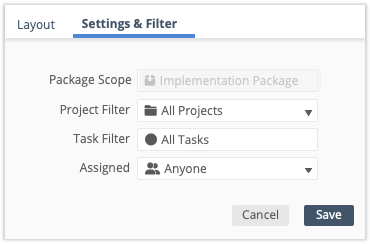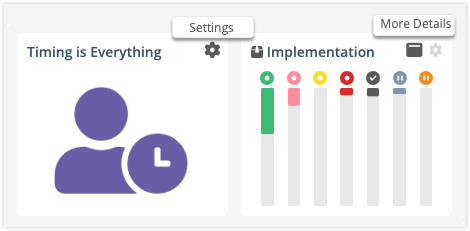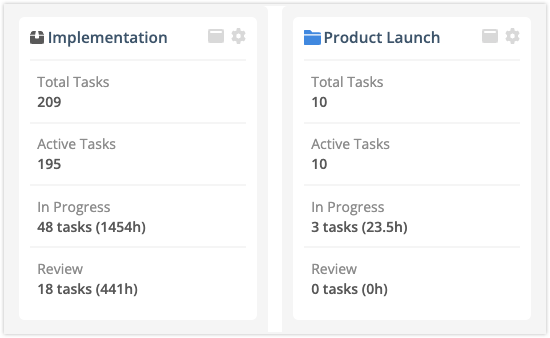Package Dashboards can be accessed from within a Package or through the Dashboard Library. To access from a Package, go to Projects in the left-side navigation, select a Package and open its Dashboard. To access via the Dashboard Library go to Dashboards in the left-side navigation. Package Dashboards can be created in any Collection: SCHEDULED, PENDING, ARCHIVED and TEMPLATES.
| 1 |
Monitor data across projects with Package Dashboards # |

Package Dashboards bring together data across all projects within a Package. Project Managers can create Package Dashboards and customize them in Design Mode. All it takes is one click on a Package Dashboard link to create a new Dashboard. After that, everyone with access to the Package sees the same widgets and data.
This lesson covers Package Dashboards. If you’re interested in tracking a single project, use a Project Dashboard instead. There are also Workspace Dashboards for monitoring projects from multiple Packages and Collections.
See the Dashboards lesson to learn about components that are common across all Dashboards: View Mode, Design Mode, Layout, Widgets, Widget Groups, Settings, Scope and Filtering. The Widgets & Groups lesson can help you decide how to display your data.
Other lessons in the Dashboards Course are: Dashboards Library, Workspace Dashboards, Project Dashboards.
| 2 |
Package Dashboard Scope & Filtering # |

Scope sets the Dashboard’s boundaries. In a Package Dashboard, scope is the Package and all the data in the dashboard comes from Members, Resources, Schedule Data, Work and Properties from Projects in the Package. Package Dashboard scope can’t be edited, but Groups and Widgets can be scoped to the Package’s Projects and Sub-Folders.
![]() Scope needs attention displays when Groups or Widgets are accidentally scoped outside the Package. If you see this warning, examine the Group and Widget Scope in Design Mode to correct the issue.
Scope needs attention displays when Groups or Widgets are accidentally scoped outside the Package. If you see this warning, examine the Group and Widget Scope in Design Mode to correct the issue.
Filtering occurs within the Dashboard Scope. Setting Dashboard Filters is optional. Groups and Widgets inherit the Dashboard Scope and Filters.
Scope and Filtering are located under Settings & Filter in Design Mode.
| 3 |
Sample Groups & Widgets on the Package Dashboard # |

A Package Dashboard starts out with twelve Widgets in two Groups. Seven widget types are represented: Image, Task Board, Schedule Summary, Workload, Metrics Tally, Project List, Task List, Changes.
Clicking More Details on the Widget performs the action defined in its Settings. It can expand into a View on the Dashboard, open a Plan Item Edit Panel or navigate to another View in the Workspace.
Project Managers can use Settings to edit widgets without leaving View Mode. For more extensive customization, go into Design Mode. Here are some things to try:
Scope Groups or Widgets to Projects and Sub-Folders.
Apply Filters to Groups, and to the Widgets that have Data Filter Settings.
Change what happens when More Details is clicked on Widgets that have On-Click Settings.
Adjust the Layout by dragging Widgets and Groups to new locations on the Dashboard.
Add more Widgets and Groups or Duplicate existing ones and change the scope and filters.
Read about the settings on sample Widgets and Groups in the Package Dashboard. . .
All the sample Widgets and Groups inherit the Dashboard Scope which is the Package. On the left side of the Dashboard, Group One has seven sample Widgets. Group Two on the right side has five sample Widgets.
Each of the Groups are using the default filters: All Projects, All Tasks, Assigned to Anyone. The tables below show the widgets in each group, what they display on the Dashboard in View Mode, what happens when More Details is clicked and the Widget filters.
| Group One Widgets | Display in View Mode | More Details | Filters |
| Image | Open settings to add an image | None | Not applicable |
| Task Board | Custom Task Status Meter | Board View on the Dashboard | All Projects, All Tasks, Assigned to Anyone |
| Schedule Summary | Project Schedule | On-Click = Schedule View navigates to Package View | All Projects, All Tasks, Assigned to Anyone |
| Workload | Top 5 Project Workload | Workload View expands on the Dashboard | Active Projects, Active Tasks, Assigned to Anyone |
| Metrics Tally | Total Work [E], Hours Logged, Remaining Estimate [E], % Complete | Metrics Tally View listing all Package Metrics | All Projects, All Tasks, Assigned to Anyone |
| Metrics Tally | Total Tasks, Active Tasks, Done Tasks, On Hold Tasks | Metrics Tally View listing all Package Metrics | All Projects, All Tasks, Assigned to Anyone |
| Changes | 5 most recent Project Changes | Changes View on the Dashboard with Project changes over the last 90 days (30 on the FREE Plan) | No filter for this widget, it inherits Dashboard and Group settings. |
Group Two has Project and Task List widgets. Clicking on a widget opens Grid View in the Dashboard. Row Click for the Project List widget navigates to the Project View. Row Click in the Task List widgets opens the Edit Panel.
| Task List Widget Name | Column Display in View Mode | Sort By | Filters |
| Project List | Project Name, Predictive Schedule, Expected Finish | Default (priority list order) | All Projects, All Tasks, Assigned to Anyone |
| At Risk Tasks | Expected Finish, Project Name | Default (priority list order) | All Projects, Custom Task Filter: Active Tasks and Schedule Risk, Assigned to Anyone |
| ASAP Tasks | Expected Finish, Assigned To, % Complete | Expected Finish (ascending order) | All Projects, Custom Task Filter: Active Tasks and ASAP, Assigned to Anyone |
| On Hold Tasks | Assigned To, Logged, % Complete | Default (priority list order) | All Projects, On Hold Tasks assigned to Anyone |
| Recently Done Tasks | Done Date, Project Name | Done Date (ascending order) | All Projects, Done Tasks, Assigned to Anyone |
| 4 |
Filtering Groups and Widgets on the Package Dashboard # |

Filtering uses AND logic to identify items that meet all the Scope and Filter criteria. We recommend applying the broadest settings on the Dashboard and narrowing them down on the Group and Widget. Filtering the Dashboard is optional.
Group Filters are set in Design Mode. Use the filter icon in the Group header to open the filter modal.
Use Settings on a Widget to access it’s filters from either View Mode or Design Mode.
List Widgets, Metrics Tally, Task Board and Workload widgets have Data Filter Settings. Learn more in the Widgets & Groups lesson.
Read more see an example of Group and Widget filtering…

In the example above, the Metrics Tally widget on the left shows data for the Implementation Package which includes information from all the projects in the package. The Group and the Widget don’t have any scope or filters applied so they inherit Package Dashboard settings:
Dashboard Scope = Package
Dashboard filters = All Projects, All Tasks, Assigned to Anyone
The Metrics Tally widget on the right shows how the data changes when scope is applied to a Group and filters are added to the Group and Widget settings.
Group Scope = Product Launch Project
Group Task Filter = Active Tasks
Widget Filter = Custom Task Filter for Name Contains “QA”.
Interpreting the widget results, there are a total of 10 Active Tasks in the Product Launch project with QA in the Task Name. Three have the Custom Task Status, “In Progress” and none of them have Custom Task Status, “Review.”
 Say hello to the new Tempo! LiquidPlanner is now Portfolio Manager.
Say hello to the new Tempo! LiquidPlanner is now Portfolio Manager. 



